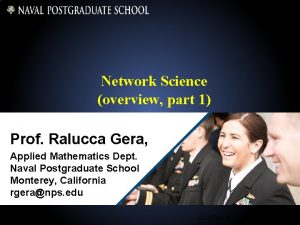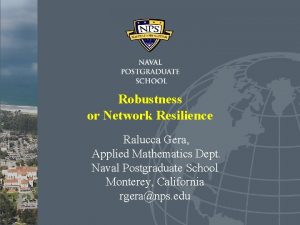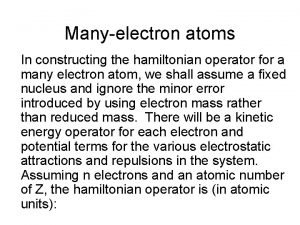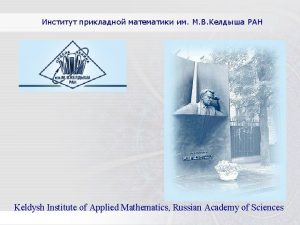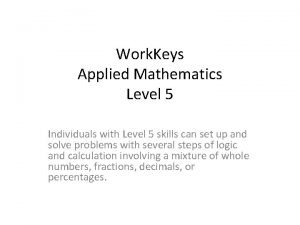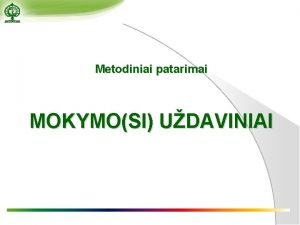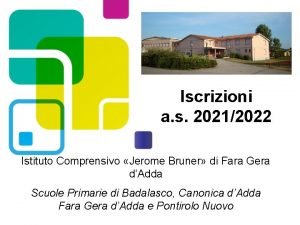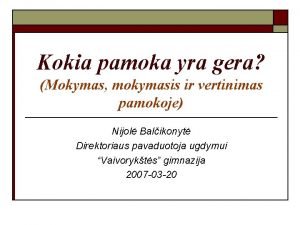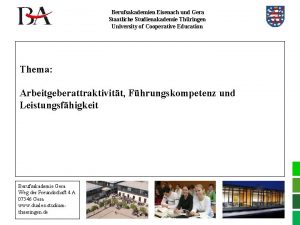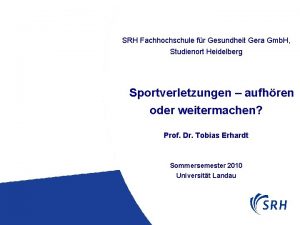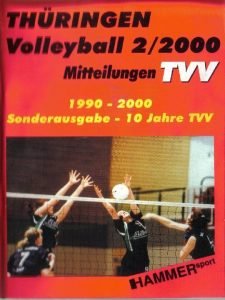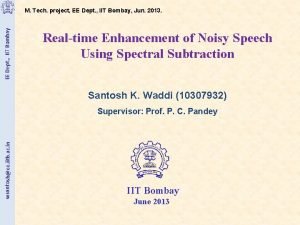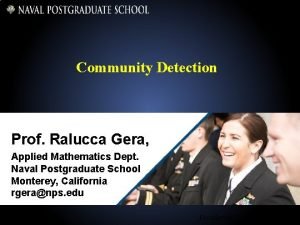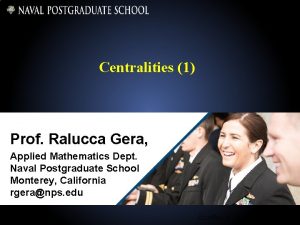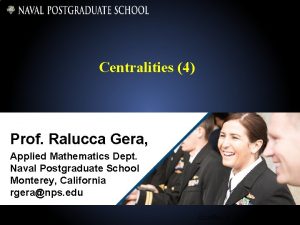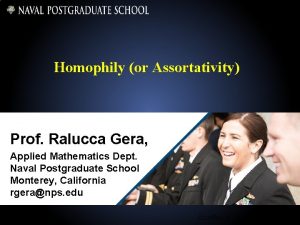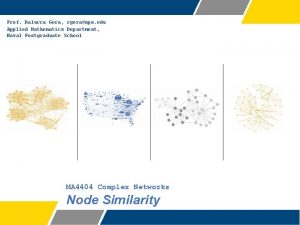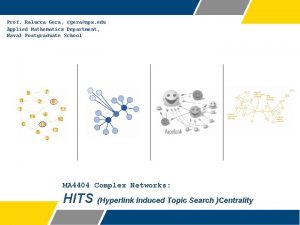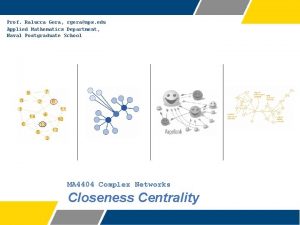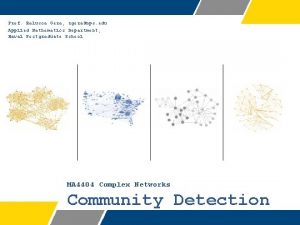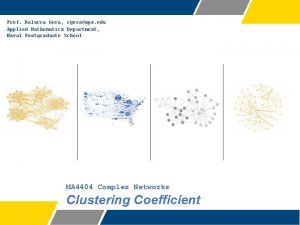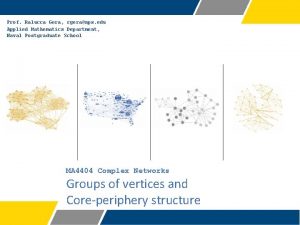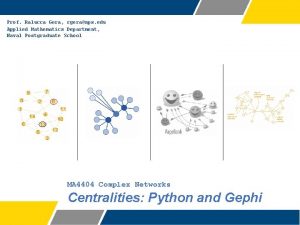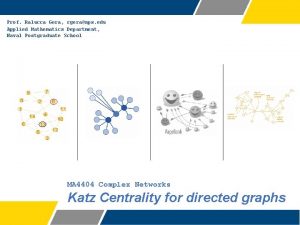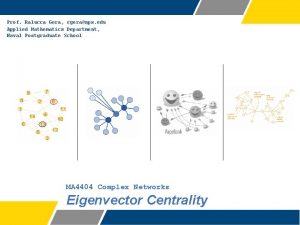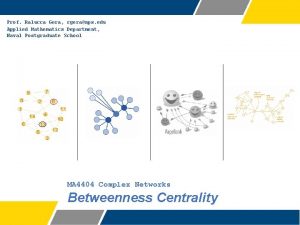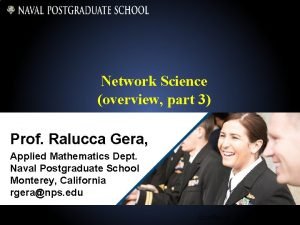Node Similarity Prof Ralucca Gera Applied Mathematics Dept















































- Slides: 47

Node Similarity Prof. Ralucca Gera, Applied Mathematics Dept. Naval Postgraduate School Monterey, California rgera@nps. edu Excellence Through Knowledge

Learning Outcomes • Building on – global properties: average degree, average clustering, ave path length – local properties: some node centralities • Understand the pairwise similarity of nodes based on position, role and structure: – Structural equivalence – Regular equivalence – Automorphic equivalence • Evaluate the correlation between pairs of nodes 2 using structural equivalence

Similarity/equivalence • In complex network, one can measure similarity – Between vertices – Between networks • We consider the similarity between vertices in the same network. • Why and how can this similarity be quantified? • Differentiating vertices helps tease apart the types and relationships of vertices – Useful for “click here for pages/movies/books/modules similar to the current one” • We determine similarities based on the network 3 structure

Types of Similarity/equivalence 4 https: //web. eecs. umich. edu/~dkoutra/tut/sdm 14_part 1 a. pdf

Introduction • Why care? How do items get suggested to users? Based on the groups they belong to, depending on • The behavior of the user • The similarity of the users to eachother (similar attitude) Hypothesis: similar nodes have similar outcomes. • There are three types of similarities: – Structural equivalence (such as Pearson Corr. Coeff) – Regular equivalence – Automorphic equivalence (automorphism classes) Of these, "automorphic" has rarely been used in substantive work, it is more theoretical than the other ones (mostly studied in graph theory: groups and graphs). 5 http: //faculty. ucr. edu/~hanneman/nettext/C 12_Equivalence. html

Automorphic equivalence Swapping same colored nodes and their neighbors maintains all of the distances among all the nodes in the graph 6 http: //faculty. ucr. edu/~hanneman/nettext/C 12_Equivalence. html https: //web. eecs. umich. edu/~dkoutra/tut/sdm 14_part 1 a. pdf

Structural equivalence Two nodes of the same color are structurally equivalent if they have the same relationships to the other neighbors, i. e. they are substitutable 7 http: //faculty. ucr. edu/~hanneman/nettext/C 12_Equivalence. html

Regular equivalence Two nodes are regularly equivalent if they have the same profile of ties with members of other sets of actors that are also regularly equivalent 8 http: //faculty. ucr. edu/~hanneman/nettext/C 12_Equivalence. html https: //web. eecs. umich. edu/~dkoutra/tut/sdm 14_part 1 a. pdf

Structural vs. Regular Equivalent nodes • Defn: Two vertices are structurally equivalent if they share many neighbors. • Defn: Two vertices are regularly equivalent if they have many neighbors that are also equivalent. 9

Structural Equivalent Excellence Through Knowledge

Structural Equivalent nodes • Two vertices are structurally equivalent if they share many neighbors • How can we measure this similarity? 11

Measuring Structural Equivalence Excellence Through Knowledge

• P. Jaccard, Bulletin de la Soci´et´e Vaudoise des Sciences Naturelles 37, 547 (1901).

Structural similarity (2) • 14 G. Salton, Automatic Text Processing: The Transformation, Analysis, and Retrieval of Information by Computer(Addison-Wesley, Reading, MA, 1989).

Cosine similarity • 15

Technique used in text analysis • T 1 T 2 …. Tt D 1 w 11 w 21 … wt 1 D 2 w 12 w 22 … wt 2 : : : Dn w 1 n w 2 n … wtn 16 Source: Raymond J. Mooney, University of Texas at Austin

Graphic Representation Example: Given terms T 2, T 2 Documents D 1, D 1 and Query Q: D 1 = 2 T 1 + 3 T 2 + 5 T 3 D 2 = 3 T 1 + 7 T 2 + T 3 Q = 0 T 1 + 0 T 2 + 2 T 3 5 D 1 = 2 T 1+ 3 T 2 + 5 T 3 Q = 0 T 1 + 0 T 2 + 2 T 3 2 3 T 1 D 2 = 3 T 1 + 7 T 2 + T 3 T 2 • Is D 1 or D 2 more similar to Q? • How to measure the degree of similarity? Distance? Angle? Projection? 7 17 Source: Raymond J. Mooney, University of Texas at Austin

Cosine Similarity Measure t 3 • Cosine similarity measures the cosine of the angle between two vectors. • Inner product normalized by the vector lengths. 1 D 1 Cos. Sim(dj, q) = 2 t 2 Q D 2 D 1 = 2 T 1 + 3 T 2 + 5 T 3 Cos. Sim(D 1 , Q) = 10 / (4+9+25)(0+0+4) = 0. 81 D 2 = 3 T 1 + 7 T 2 + 1 T 3 Cos. Sim(D 2 , Q) = 2 / (9+49+1)(0+0+4) = 0. 13 Q = 0 T 1 + 0 T 2 + 2 T 3 D 1 is 6 times better than D 2 using cosine similarity 18 Source: Raymond J. Mooney, University of Texas at Austin t 1

Illustration of 3 Nearest Neighbor for Text It works the same with vectors of the adjacency matrix, where the terms are just the neighbors, and similarity is how many common neighbors there are query 19 Source: Raymond J. Mooney, University of Texas at Austin


(Degree) Pearson Correlation Coeff (1) • 21

Pearson Correlation Coeff (2) • 22

Pearson Correlation Coeff (3) •

Pearson Correlation Coeff (4) •

More measures • 25

Overview updated: Structural similarity • https: //networkx. github. io/documentation/networkx-1. 9/reference/generated/networkx. algorithms. assortativity. degree_pearson_correlation_coefficient. html

Regular Equivalent Excellence Through Knowledge

Structural vs. Regular Equivalent nodes • Defn: Two vertices are structurally equivalent if they share many neighbors. • Defn: Two vertices are regularly equivalent if they have many neighbors that are also equivalent. 28

Why? https: //web. eecs. umich. edu/~dkoutra/tut/sdm 14_part 1 a. pdf

Defn of regular Equivalence Defn. Two nodes are regularly equivalent if they are equally related to equivalent nodes (i. e. their neighbors need to be equivalent as well). We capture equivalence through color pattern adjacencies. To have similar roles, these nodes need different colors because of their adjacencies 30 White and Reitz, 1983; Everette and Borgatti, 1991

The Borgatti-Everett Network Structural: Nodes adjacent to a set of nodes (substitutable based on the access to info) vs. Regular: Nodes adjacent to similar roles in the network (similar positions in the network). 31 http: //www. stats. ox. ac. uk/~snijders/Equivalences. pdf

Algorithm for Regular Equivalence Excellence Through Knowledge

Regular Equivalence (1) • S. P. Borgatti and M. G. Everett, Social Networks 15, 361 (1993). 33

Regular Equivalence (2) • 34

Regular Equivalence (3) •

Regular Equivalence (4) • j k Leicht, Elizabeth A. , Petter Holme, and Mark EJ Newman. "Vertex similarity in networks. " Physical Review E 73. 2 (2006): 026120. 36

Regular Equivalence (5) • 37

Regular Equivalence (6) • 38

The connection between Regular and Structural Equivalence Excellence Through Knowledge

Equivalence (1) • 40

Equivalence (2) • 41

References • Newman, Mark. Networks: An introduction. Oxford university press, 2010. • Everett, Martin G. , and Steve Borgatti. "Role colouring a graph. " Mathematical Social Sciences 21. 2 (1991): 183 -188. • White, Douglas R. , and Karl P. Reitz. "Graph and semigroup homomorphisms on networks of relations. " Social Networks 5. 2 (1983): 193 -234. • Leicht, Elizabeth A. , Petter Holme, and Mark EJ Newman. "Vertex similarity in networks. " Physical Review E 73. 2 (2006): 026120. • https: //www. cs. utexas. edu/~mooney/ • http: //www. stats. ox. ac. uk/~snijders/Equivalences. pdf • http: //faculty. ucr. edu/~hanneman/nettext/C 12_Equivalence. html • https: //web. eecs. umich. edu/~dkoutra/tut/sdm 14_part 1 a. pdf 42

• Backup slides 43

https: //web. eecs. umich. edu/~dkoutra/tut/sdm 14_part 1 a. pdf

https: //web. eecs. umich. edu/~dkoutra/tut/sdm 14_part 1 a. pdf

https: //web. eecs. umich. edu/~dkoutra/tut/sdm 14_part 1 a. pdf

http: //www. stats. ox. ac. uk/~snijders/Equivalences. pdf
 Ralucca gera
Ralucca gera Ralucca gera
Ralucca gera Ralucca gera
Ralucca gera Typedef struct in c
Typedef struct in c Reference node and non reference node
Reference node and non reference node Radial node angular node
Radial node angular node Reference node and non reference node
Reference node and non reference node Struct node int data struct node* next
Struct node int data struct node* next Wavelength constructive interference
Wavelength constructive interference Keldysh institute of applied mathematics
Keldysh institute of applied mathematics Workkeys applied mathematics level 5 answers
Workkeys applied mathematics level 5 answers Gera pamoka
Gera pamoka Gera noordzij
Gera noordzij Ic fara
Ic fara Pamokos uždaviniai pavyzdžiai
Pamokos uždaviniai pavyzdžiai Berufsakademie gera
Berufsakademie gera Mary_srh
Mary_srh Klemens müller gera
Klemens müller gera Norma gera
Norma gera Projeto gentileza gera gentileza ensino médio
Projeto gentileza gera gentileza ensino médio Culto ao fantástico
Culto ao fantástico Dept a
Dept a Dept of education
Dept of education Gome dept
Gome dept Dept. name of organization
Dept. name of organization Affiliate disclodures
Affiliate disclodures Dept of education
Dept of education Ohio employment first
Ohio employment first Gome dept
Gome dept Department of agriculture consumer services
Department of agriculture consumer services Ee dept iitb
Ee dept iitb Central islip fire department
Central islip fire department Tabella chemical shift c13
Tabella chemical shift c13 Hoe dept
Hoe dept Mn dept of education
Mn dept of education La revenue dept
La revenue dept Florida dept of agriculture and consumer services
Florida dept of agriculture and consumer services Gome dept
Gome dept Finance dept structure
Finance dept structure Dept ind onegov
Dept ind onegov Pt dept logistik
Pt dept logistik Rowan county social services
Rowan county social services Firefighter interview tips
Firefighter interview tips Liz welch mississippi
Liz welch mississippi Poster affiliation
Poster affiliation Rewley house continuing education library
Rewley house continuing education library Florida dept of agriculture and consumer services
Florida dept of agriculture and consumer services Horizontal
Horizontal
